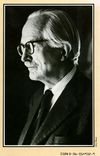Death Has Deep Roots: Difference between revisions
imported>Hayford Peirce (rewrote the lede and will begin a very short plot summary in another section) |
imported>Hayford Peirce (→Plot: starting to fill in the plot) |
||
| Line 6: | Line 6: | ||
==Plot== | ==Plot== | ||
The setting is London about 1950. Victoria Lamartine, a young French woman currently working at a small family hotel in Soho, has been arrested for the murder of an English major whom she had previously known in France during the war. Lamartine was active in the Resistance and, the prosecution asserts, had had a child fathered by the major, who was liaising with the French maquisards. After being arrested by the [[Gestapo]] she nevertheless bears the child and survives the war. The child dies no long afterwards and Lamartine comes to London to work in the hotel. She also makes continual efforts to local the major but, for some years, to no avail. Finally, just before the story opens, he agrees to meet her one evening at her hotel. Shortly thereafter he is found dead in his room, stabbed in the manner that the Resistance taught. Lamartine is arrested and charged with his murder. | |||
A young solicti | |||
Nap Rumbold, a junior solicitor in his father's London firm, is asked by Lamartine to represent her. Nap himself had spent four months on dangerous missions with the French maquis in occupied France and is a retired Lieutenant-Colonel, D.S.O. | |||
Revision as of 16:22, 17 January 2017
Death Has Deep Roots is the fifth novel by the British mystery writer Michael Gilbert. It was published in England by Hodder and Stoughton in 1951 and in the United States by Harper & Brothers in 1952. It is basically a classical courtroom trial story but with almost equally important thriller elements juxtaposed with the courtroom scenes. Although Inspector Hazlerigg, who had appeared in all of Gilbert's earlier novels as a mostly leading character, plays a role in this story, it is only in two brief appearances, once towards the beginning of the book and once again near the end. Two of the three main characters in this book are from previous novels, Major Angus McMann (They Never Looked Inside) and Noel Anthony Pontarlier ("Nap") Rumbold (The Doors Open). The other leading character, the trial barrister Hargest Macrae, also appears in some of Gilbert's early short stories.
Plot
The setting is London about 1950. Victoria Lamartine, a young French woman currently working at a small family hotel in Soho, has been arrested for the murder of an English major whom she had previously known in France during the war. Lamartine was active in the Resistance and, the prosecution asserts, had had a child fathered by the major, who was liaising with the French maquisards. After being arrested by the Gestapo she nevertheless bears the child and survives the war. The child dies no long afterwards and Lamartine comes to London to work in the hotel. She also makes continual efforts to local the major but, for some years, to no avail. Finally, just before the story opens, he agrees to meet her one evening at her hotel. Shortly thereafter he is found dead in his room, stabbed in the manner that the Resistance taught. Lamartine is arrested and charged with his murder.
A young solicti
Nap Rumbold, a junior solicitor in his father's London firm, is asked by Lamartine to represent her. Nap himself had spent four months on dangerous missions with the French maquis in occupied France and is a retired Lieutenant-Colonel, D.S.O.
The war
Anthony Boucher of the New York Times said that "the first 1952 book to reach this reviewer's desk is one which wouldn't disgrace any Best-of-the-Year list" and went on to say that it concerned:
...an important murder trial, with real understanding of courtroom psychology and technique. But the camera eye of the author constantly flashes from this... to the efforts of two likable and believable amateurs detectives who are striving to assemble last-minute evidence for the defense; and their adventures, involving maquisards and collaborators from the past, and gold-smugglers and secret agents of the present, make a thriller as wildly exciting as the courtroom scenes are suavely persuasive. It's hard to recall any technical tour de force of fusion quite so admirably integrated as this. Mr. Gilbert is one of the most accomplished leaders of the new British school of murder writing.[1]
A much later appraisal comes from Barzun and Taylor's encyclopedic Catalogue of Crime:
There have been many mystery tales based upon the activities of the French Resistence; few have been good, and fewer stand up to current rereading. This is one of the very best... Scene of the crime is a small London hotel. Counsel of both sides are excellently portrayed. A gripping tale: one of the author's triumphs.[2]
Style and Contents
The style is, in actuality, a
Credibility
As in many crime or mystery stories,.
Notes
- ↑ Criminals at Large, "The New York Times", 6 January 1952 at [1]
- ↑ Jacques Barzun & Wendell Hertig Taylor, A Catalogue of Crime, Harper & Row, New York, "Second Impression Corrected", 1973, page 208
